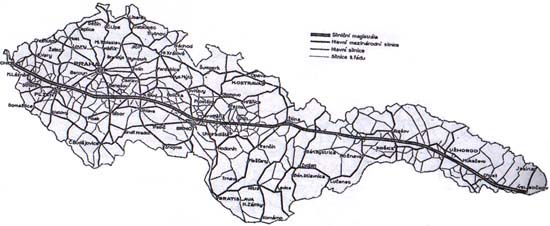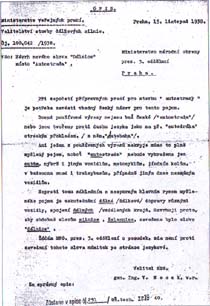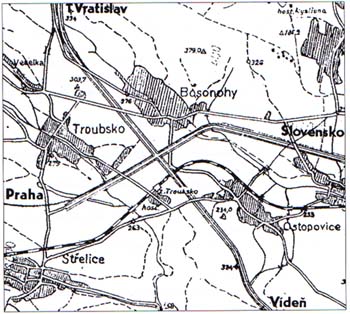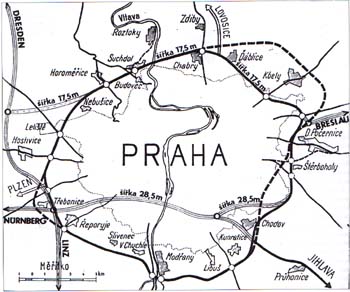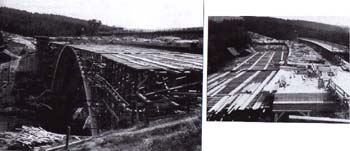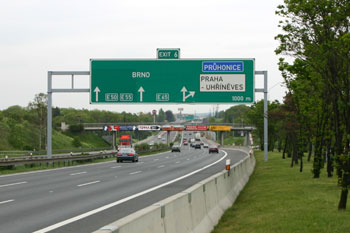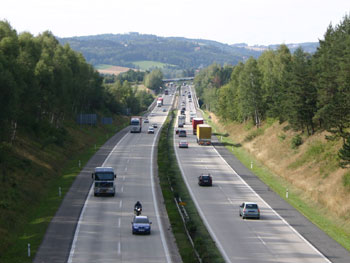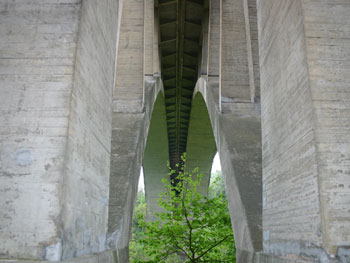Extensive article about the history of motorway construction in the territory of the Czech Republic
The beginning of motorway construction is for most users of motorways associated with the period of late 1960's. In fact, we began the construction of motorways before 2nd world war as one of the first countries in the world. First concrete ideas to build a road across our republic appeared in the year 1935. The project was named "National Road Plzeň – Košice" and it did not go, from today's point of view, through important centers of concentration of population, like Prague or Brno. The Brno Region presented the second proposal. Its project of a trunk road called "Cheb – Chust" consisted in the section Cheb – Košice from a northern and a southern road. One road then continued from Košice to Chust situated in the Transcarpathian Ukraine. Neither of these propositions, however, had won any sympathy with the authorized bodies, and neither was realized. J. A. Baťa, an industrialist from Zlín, came up with an interesting idea when he proposed a trunk road across Czechoslovakia from Cheb to Velký Bočkov (a town on the border between the Ukraine and Romania today). The project of the whole route was developed at Baťa's own expense. This project again by-passed the important centers of concentration of population and industry in our republic. Relevant authorities approved the project.
After the Munich Treaty from September 30, 1938, Czechoslovakia lost a considerable part of its territory. The plans for the development of road network therefore had to be changed at short notice. The Land Bureau in Prague developed in a record-breaking time period of twelve days brand new routes for the arterial road Prague – Jihlava and for the ring road around Prague. Everything was published in the form of a map in the scale of 1:25,000. On November 4, 1938, the Cabinet approved a proposal for the introduction of driving on the right side of the road coming into effect on May 1, 1939. On the same day a proposal to establish the Directorate of Construction of Long-Distance Roads (Velitelství stavby dálkových silnic – VSDS) was presented. The institution was established with Brigadier Ing. Václav Nosek as director. On November 5, 1938 a decision was made to develop general as well as detailed projects of an arterial road Prague – Jihlava – Brno – Zlín – Slovak border. On November 19, 1938, representatives of German and Czechoslovak governments (on behalf of our government General Husárek) signed an agreement about the construction of a "German" motorway from Breslau (today's Wroclaw) through our territory to Vienna. It should cross our arterial road near Brno. On December 1, 1938 the Germans commenced the construction of the so-called Sudeten Motorway (at that time on German territory): Streitau (in Bavaria) – Cheb – Karlovy Vary – Lovosice – Česká Lípa – Liberec – Goerlitz (in Saxony). On December 23, 1938, VSDS was renamed to General Directorate of Motorway Construction (Generální ředitelství stavby dálnic – GŘSD) and the term "motorway" ("dálnice" in Czech) was formally introduced. The term is derived from the basis of Czech words for railway and road – "železnice" and "silnice" – and it emphasizes the long-distance character of traffic (long-distance = "dálkový"). The author of the term is Staff Captain Ing. Karel Chmel.
On January 13, 1939, the government approved an official proposal for the route of motorway Prague – Jihlava – Brno – Slovak border and at the same time gave consent to groundwork in section Chodov u Prahy – Humpolec, and in section Zástřizly – Lužná near Vsetín. On January 24, 1939, the construction in section Zástřizly – Lužná officially began with surveying, tree felling of the forest in Chřiby, etc. Similar works were commenced in the Sázava valley in February.
On March 14, 1939, the declaration of the independent Slovak State definitely limited the preparation of motorways in the competence of GŘSD to the territory of the so-called historical lands (Bohemian Lands and Moravian-Silesian Lands). From March 17, 1939, driving on the right side of the road was introduced. The official date of May 1 was not kept. This was connected with the formation of the Protectorate Bohemia and Moravia on March 16, 1939. After the formation of the Protectorate came a regulation stating that Czech motorways should be integrated into the German road network. It primarily brought stricter requirements for the parameters of motorways. The proposed speed was raised from 120 kph to 160 kph; the width was increased in section Chodov u Prahy – Lensedly and in the surroundings of Brno from the original 21 metres to 28.5 metres, and in the rest to 22 metres. The modification also affected the cross fall and the longitudinal fall, as well as the permitted curve radius. On April 11, 1939, began the construction of motorway Breslau – Vienna in the length of 83.5 km, 76 km on the territory of the Protectorate. In reality, construction of the remaining sections never started.
Towards the end of April 1939, GŘSD assigned several parts of the construction of motorway Prague – Brno – Slovak border to Czech construction firms. At the same time, these constructions were supposed to be put into operation already on October 31, 1939, which is an extremely short period of time from today's point of view. 400 – 600 people had to be employed on each 5 kilometres long section in order to keep the deadline. The opening ceremony of the construction took place on the third kilometre of the future route near Průhonice on Tuesday, May 2, 1939. The first dig was performed by the Managing Director of GŘSD, Ing. Václav Nosek. In August 1939, the construction works were in full progress on seven construction parts of route Prague – Jihlava and on one part of route to Slovak border.
The works on five construction sections Prague – Jihlava had just begun. Discussions concerning the route of the motorway around Brno were the reason for constant work on the designs. Survey field works began in September 1939 on section Prague – Plzeň. Two longest bridges on the route (above Beroun and in near Plzeň) were being prepared individually. In the year 1940 detailed plans were laid out and the plan from the year 1939 calculated with the beginning of construction in the years 1941 and 1942. The by-pass of Plzeň was planned on the northern side. The planning of route Prague – Lovosice was similar to that of route Prague – Plzen. The route was originally planned in approximately the same way as today's motorway D8. The route was changed after modifications performed on the Prague ring road. A detailed project was developed in the period 1941 – 1943. Research of routes for roads Prague – Náchod, Prague – České Budějovice and for the complementary section Jihlava – Znojmo were being prepared.
The road surface was to be on about two thirds of its length made out of concrete, the remaining third was to be made out of sett paving! A concentration area of services, or what could be called a supply point, was planned (from today's point of view an analogy of fully equipped large service areas). Supply points were situated at the points of access of roads to the motorway, so that vehicles could be able to refuel straight after they entered the motorway. Two basic types of supply points were distinguished – small one and large one.
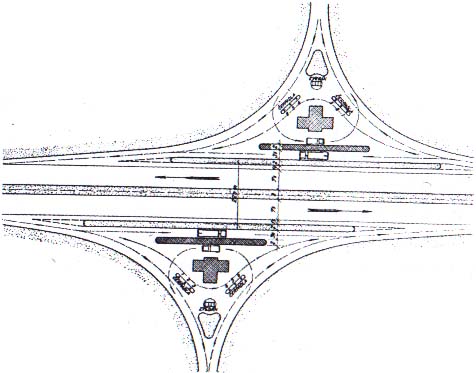
"Velké zásobiště" – "Large Supply Point"
Smaller rest areas situated on locations adequate to the countryside would serve for a shorter rest. The motorway was to be divided into section of a maximum length of 60 km, which would be administered by a road-master in order to ensure continual rideability. Roadmen, or road-menders, would be subordinate to the road-master. Road units should be situated on sections 7 – 10 km long. A communication service with a member of staff on duty in sections of 10 – 15 km would serve for quick emergency calls in cases of road accidents or breakdowns. Telephone stations for emergency calls in sections of 2 – 3 km were planned.
On October 11, 1939, General Inspector of German Roads in Berlin received a letter written by Ing. Václav Nosek which was a direct consequence of the beginning of the war. The Managing Director of GŘSD mentions in his letter the main causes of a slower progress of construction than expected. Nosek stated the following main causes for the hindrance: shortage of workers (100 – 200 workers worked on each section instead of the necessary 600), shortage of machinery (which was ordered from Germany but not delivered because of the war), insufficient supplies of fuel and food. With this letter, Nosek asked the authorities of the Reich to meet the requests of our authorities. Twenty-one construction companies worked on the construction of our motorway in November 1939. The average overall number of workers in 1939 was 1,846, in November even 2,673 workers.
Preparations of other motorways started at the beginning of 1940: sections Prague – Lovosice and Prague – Plzeň. The planning was assigned to construction companies that should participate in the future construction of the motorway. Parallel research of routes Prague – Náchod and Prague – České Budějovice was carried out. It was decided on January 22, 1940 that Reichsautobahngesellschaft (RAG) will perform the construction of the clover-leaf junction in the Bosonohy – Troubsko area near Brno, including the appropriate section of our motorway. This junction marks the above-mentioned crossing of our motorway with "German" motorway Breslau – Vienna. The section of our motorway was to be charged to GŘSD.
In June 1940 GŘSD started the re-plotting of section Zástřizly – Slovak border in order to solve satisfactorily the descent of the motorway into the Morava valley. In the same month the first section of the motorway near Chodov u Prahy began to take shape. Estimated 80 % of earthworks were finished. Laying of concrete pavements should begin in September. The progress of laying depended primarily on the finishing of two motorway bridges (over the Botič brook and over the road Uhříněves – Průhonice), so that the finishers would be able to lay continuously the concrete pavement in this section. In August 1940, Ing. Karel Míša presents at the Ministry his proposal to ban the construction of concrete roads in fear of shortage of steel for the bolting of joints and reinforcement of roads. The ruling of GŘSD from August 20, 1940, declared the ban. As a result, only a short section of concrete lay-by lanes remained in the first part of the construction Prague – Jihlava near Chodov u Prahy. The remaining concrete works were postponed to building season 1941. During September 1940 other motorway sections were assigned for construction in the area of the Sázava river near Hvězdonice, in the surroundings of Český Šternberk and near Humpolec. On October 7 began the works on the newly assigned section near Humpolec in the area of the junction with the road Humpolec – Pelhřimov. The body of the motorway section Zástřizly – Slovak border in the East of Bohemia began to take shape on the location of its crossing with the road Kyjov – Kromeříž. At the end of 1940 the construction was in full progress on eleven sections and works on another three sections were about to begin. Construction works were in progress on three sections in Moravia. Czech variant of the crossing of our motorway with the German motorway was approved finally. However, the German variant won in the project for the solution of the Prague ring road, i. e. tangent solution in two sections: Lovosice – České Budějovice and Plzeň – Náchod. In connection, following sections were assigned to Czech construction firms in the spring of 1941: section Vltava – new beginning of the motorway in Spořilov (today it follows in a larger part the planned Prague inner-city ring road), and the link between the Prague ring road in Spořilov and the original beginning of the motorway to Brno.
The construction of the "German" motorway continued in the whole section of 83 km, yet the progress was behind the original assumption. The works on the crossing of this motorway with our motorway in the Troubsko – Bosonohy area also commenced. At the beginning of July 1941 there already was a general awareness at the construction site of the motorway about the forthcoming reduction of work after August 1, 1941. Therefore, particular works were selected that were necessary to be completed on individual parts of the construction, in order to prevent devaluation of the work so far completed. Construction of carriageways was, of course, not to be found on this list. Building of some big bridges also started in the summer of 1941. The span of the arch of the bridge over the valley of brook Šmejkalka near Senohraby was 120 metres, which made it the largest of all arched bridges planned for the motorway Prague – Brno – Slovak border. Other bridges were being built in a badly accessible area of the river Želivka near Dolní Kralovice. The unfinished Czech section ended, with the exception of minor works near Humpolec, about four kilometres behind the construction site of the bridge over the river Želivka. The expected ban of construction activities came on August 1, 1941. The large-scale plan of the development of traffic infrastructure was thwarted. There were 153 km of motorways on the territory of the Protectorate at that time: 77 km of the Czech motorway Praha – Brno – Slovak border under the jurisdiction of GŘSD and 76 km of the "German" motorway Breslau – Vienna in the competence of RAG. Twenty-five construction companies were working on 18 sections of the Czech motorway for the time being. On August 11, 1941, GŘSD was granted an exemption from the ban on construction works approved directly by Reich Protector Konstantin von Neurath. It concerned, however, mainly the necessary completion of unfinished constructions in order to prevent their devaluation. The exemption did not apply on new constructions. In Chřiby, on the other hand, the works should continue in full scale on all three unfinished sections even after August 1, 1941. The construction of the unfinished bridges continued in unaltered extent. The ban on the usage of concrete ended the construction season of the year 1941 on October 31, 1941. Work continued on three big bridges on the route Prague – Jihlava. In the spring of 1942, only a small number of workers came to work at the construction of the motorway – 30 workers per section on average. Construction works on all assigned sections of the motorway continued only in a very limited extent. In the evening of April 30, 1942, construction works on all unfinished sections of the motorways were definitively ended. Construction thus continued only on three arched bridges over the brook Šmejkalka, over the valley of the Sedlický brook and over the Želivka valley. They were categorised as constructions of highest importance. On May 30 constructions of bridges over the valley of the Sedlický brook and over the Želivka valley were stopped as ordered. The bridge over the valley of the brook Šmejkalka near Senohraby remained under construction. Only cleaning and custodial works continued in the remaining sections. All works stopped on July 7 and an undisturbed peace fell over all construction sites. Only "Construction Supervision for the Duration of the Cessation of Construction" established by GŘSD worked there. It mainly watched the individual sections to prevent stealing of material. All remaining reinforcement steel was confiscated in December 1942 and the Department of Bridges of the GŘSD stopped the still running construction of the bridge over the valley of Šmejkalka. 42 % of the bridge were completed. The arch of the right bridge was concreted. The arch formwork was finished on the left bridge.
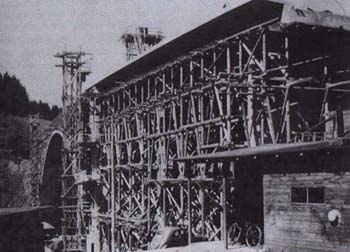
Construction of the bridge over the Želivka river valley near Píšť in 1942
During 1943 GŘSD provided only supervision on all unfinished constructions in the form of "Construction Supervisions for the Duration of the Cessation of Construction". They worked in a similar manner on the whole unfinished motorway almost till the last days of the war. The situation on the construction site of the "German" motorway Breslau – Vienna was no different from the situation on our motorway.
May 9, 1945, brought the end of occupation. There were three unfinished motorways on our territory in a total length of 188 km after the re-institution of the Czechoslovak Republic. Besides the motorway Prague – Brno – Slovak border, with unfinished sections of total length of 77 km, it was the motorway from the formerly German town of Breslau (now Polish Wroclaw) to Vienna continually in construction between Městečko Trnávka near Moravská Třebová and Ledce u Rajhradu near Brno in the length of 83 km, and the "Sudeten Motorway", sections of which near Cheb and Liberec gave the length of 28 km (precise measurements cannot be made). During July 1945 custodial works began again on the construction of Motorway Prague – Humpolec, although unofficially and in only a minimal extent. The Czechoslovak Republic was not interested in the continuation of construction of any of the "German" motorways on our territory.
President Beneš, upon his return from exile, issued a decree on November 1, 1945, which, among other matters, ordered the completion of building of motorway Prague – Brno – Slovak border. During a session concerning the completion of the motorways on November 28, 1945, the participants agreed on a retrogressive reduction of parameters introduced by the General Inspectorate of German Motorways in 1939. There also prevailed an opinion that the traffic boom of the 1930's will not again repeat itself. It meant reduction of the proposed speed from 160 kph to 120 kph, decrease of the width of the motorway body to 21 metres, decrease of the size of a minimal curve radius to 500 m, and increase of maximum longitudinal falls to 7 % (it is necessary to admit here that the return to the original 8 % is not convenient). Also the importance of lay-by lanes was reduced and those should be reinforced by macadam only. The programme of the completion of the motorway divides the section between Prague and Humpolec into three parts: Prague – Senohraby, Senohraby – Dolní Kralovice, and Dolní Kralovice – Humpolec. The government approved conclusions reached during the session by the end of the year 1945. In August 1946 construction continued in a small extent on most of the sections of motorway Prague – Humpolec. The firms that started the construction of individual sections in most cases also continued. The fate of the unfinished sections in Chřiby had not been decided by that time. Despite that, the firms performed custodial works in those sections. An increased extent of work was planned only for the first parts of the construction of the route from Prague. Construction of roads that would link Praha with the Sázava valley was planned for the period 1948 – 1949.
The Ministry of Engineering prevented in 1947 attempts to worsen the plotting parameters of the motorway. The ministry also enforced the introduction of some positive elements, e. g. the increase of curve radiuses. Nationalization of construction companies in February 1948 had the biggest impact on the construction of the motorway. The companies, however, continued in the building of the motorway. In spite of a very low number of workers, the finishing works progressed in a relatively swift manner. The arched bridge over the Šmejkalka valley was finished by the original construction company, now incorporated into the National Enterprise Konstruktiva. The concreting of the left deck of the bridge over the Želivka valley near Píšt started in the summer of 1948.
The year 1949 did not begin very well for the completion of the motorway as far as the organization is concerned. The completion of the motorway in section Prague – Humpolec was subordinate to the Regional National Committees (KNV) in Prague and Jihlava. The unfinished section in Chřiby was definitively left to its fate. As the end of the construction season 1949 approached, so did the completion of all main bridges between Prague and Humpolec.
On December 19, 1950 the Ministry of Engineering was dissolved and the completion of the motorway was not in plan anymore. Some of the bridges were thus not finished. The construction site was definitively abandoned and vegetation started to grow there. 77 km of the body of the motorway left in various stages of construction and 60 bridges remained in the countryside between Prague and Humpolec, and in Chřiby. A short section of finished concrete lay-by lanes in both directions near Průhonice (near Prague) remain as a reminder of the year 1939.
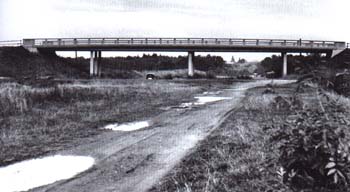
Section of the unfinished motorway near Průhonice (near Prague) in 1960's
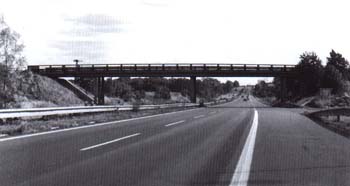
The same location in 1980's (motorway D1)
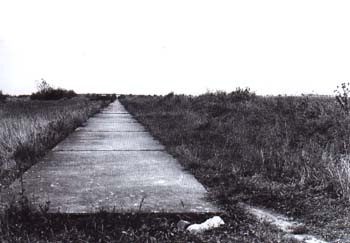
In November 1939, 2.25-metre-wide lay-by lanes were concreted near Čestlice u Prahy.
Picture taken in 1960's
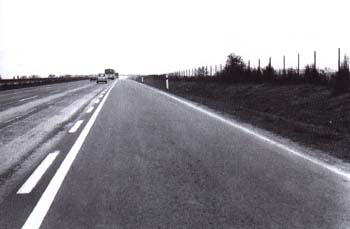
The same location in 1980's (motorway D1)
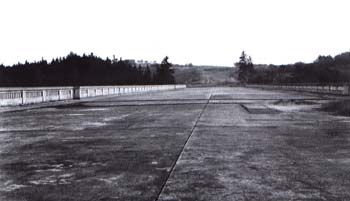
Bridge over the valley of the brook Šmejkalka near Senohraby.
Picture taken in 1966
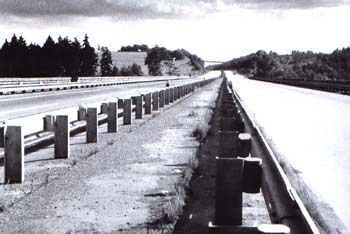
The same location in 1980's (motorway D1)
The construction of both "German" motorways on our soil in total length of 111 km was practically abandoned already in 1942. An unbelievable figure of 188 km of unfinished motorways on the territory of Czechoslovakia was therefore condemned to a gradual decay in 1950. Our prominent position as motorway builders, which we gained at the end of the 1930's, had been lost forever. The solution of road and traffic problems was postponed for much later periods. The impressive unfinished constructions of our and both German motorways have remained for many years a silent memory of a wasted opportunity.
At the end of the 1950's the volume of road traffic had started to grow again and it soon exceeded the level of road traffic from the pre-war times. The rapid grow of individual motorism, which in many road section almost reached the maximum level of their traffic capacity, served as an impulse for the modernization of the road network. In 1963 a road network was selected for priority modernization. The shape and the extent of the motorway network were also established. The construction of motorway D1 (Prague – Brno) started in 1967. The first section (21 km) from Prague to Mirošovice was put into operation on July 12, 1971. The motorway linked Prague and Brno in 1980, 40 years later than originally planned.
